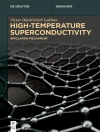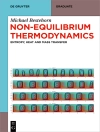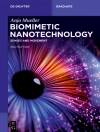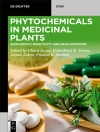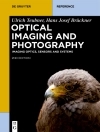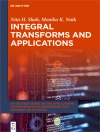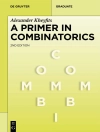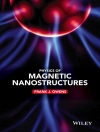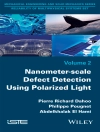A panel of internationally renowned scientists discuss the latest results in plasma technology. This volume has been compiled with both a didactic approach and an overview of the newest achievements for industrial applications. It is divided into two main sections. One is focused on fundamental technology, including plasma production and control, high-pressure discharges, modeling and simulation, diagnostics, dust control, and etching. The section on application technology covers polymer treatments, silicon solar cell, coating and spray, biomaterials, sterilization and waste treatment, plasma propulsion, plasma display panels, and anti-corrosion coatings. The result is an indispensable work for physicists, chemists and engineers involved in the field of plasma technology.
Tabla de materias
Preface XV
List of Contributors XVII
1 Basic Approaches to Plasma Production and Control 1
N. Sato
1.1 Plasma Production 2
1.1.1 Under Low Gas Pressure (<0.1 torr) 2
1.1.2 Under Medium Gas Pressure (0.1–10 torr) 4
1.1.3 Under High (Atmospheric) Gas Pressure (>10 torr) 6
1.2 Energy Control 7
1.2.1 Electron-Temperature Control 7
1.2.2 Ion-Energy Control 10
1.3 Dust Collection and Removal 11
References 15
2 Plasma Sources and Reactor Configurations 17
P. Colpo, T. Meziani, and F. Rossi
2.1 Introduction 17
2.2 Characteristics of ICP 18
2.2.1 Principle 18
2.2.2 Transformer Model 19
2.2.3 Technological Aspects 20
2.3 Sources and Reactor Configuration 23
2.3.1 Substrate Shape 23
2.4 Conclusions 31
References 32
3 Advanced Simulations for Industrial Plasma Applications 35
S.J. Kim, F. Iza, N. Babaeva, S.H. Lee, H.J. Lee, and J.K. Lee
3.1 Introduction 35
3.2 PIC Simulations 37
3.2.1 Capacitively Coupled O2/Ar Plasmas 37
3.2.2 Three-Dimensional (3D) Charge-up Simulation 42
3.3 Fluid Simulations 47
3.3.1 Capacitively Coupled Discharges 48
3.3.2 Large Area Plasma Source 49
3.4 Summary 51
References 52
4 Modeling and Diagnostics of He Discharges for Treatment of Polymers 55
E. Amanatides and D. Mataras
4.1 Introduction 55
4.2 Experimental 56
4.3 Model Description 57
4.4 Results and Discussion 60
4.4.1 Electrical Properties 61
4.4.2 Gas-Phase Chemistry 66
4.4.3 Plasma–Surface Interactions 71
4.5 Conclusions 72
References 73
5 Three-Dimensional Modeling of Thermal Plasmas (RF and Transferred Arc) for the Design of Sources and Industrial Processes 75
V. Colombo, E. Ghedini, A. Mentrelli, and T. Trombetti
5.1 Introduction 76
5.2 Inductively Coupled Plasma Torches 77
5.2.1 Modeling Approach 77
5.2.2 Selected Simulation Results 82
5.2.2.1 High-Definition Numerical Simulation of Industrial
5.3 DC Transferred Arc Plasma Torches 85
5.3.1 Modeling Approach 85
5.3.2 Selected Simulation Results 89
References 95
6 Radiofrequency Plasma Sources for Semiconductor Processing 99
F. F. Chen
6.1 Introduction 99
6.2 Capacitively Coupled Plasmas 99
6.2.1 Dual-Frequency CCPs 100
6.3 Inductively Coupled Plasmas 103
6.3.1 General Description 103
6.3.2 Anomalous Skin Depth 106
6.3.3 Magnetized ICPs 107
6.4 Helicon Wave Sources 109
6.4.1 General Description 109
6.4.2 Unusual Features 110
6.4.3 Extended Helicon Sources 114
References 114
7 Advanced Plasma Diagnostics for Thin-Film Deposition 117
R. Engeln, M.C.M. van de Sanden, W.M.M. Kessels, M. Creatore, and D.C. Schram
7.1 Introduction 117
7.2 Diagnostics Available to the (Plasma) Physicist 118
7.3 Optical Diagnostics 118
7.3.1 Thomson–Rayleigh and Raman Scattering 118
7.3.2 Laser-Induced Fluorescence 121
7.3.3 Absorption Techniques 122
7.3.4 Surface Diagnostics 126
7.4 Applications 127
7.4.1 Thomson–Rayleigh Scattering and Raman Scattering 127
7.4.2 Laser-Induced Fluorescence 128
7.4.3 Absorption Spectroscopy 130
7.4.4 Surface Diagnostics 133
References 134
8 Plasma Processing of Polymers by a Low-Frequency Discharge with Asymmetrical Configuration of Electrodes 137
F. Arefi-Khonsari and M. Tatoulian
8.1 Introduction 137
8.2 Plasma Treatment of Polymers 139
8.2.1 Surface Activation 139
8.2.2 Functionalization (Grafting) Reactions 139
8.2.3 Crosslinking Reactions 140
8.2.4 Surface Etching (Ablation) Reactions 142
8.3 Surface Treatment of Polymers in a Low-Frequency, Low-Pressure Reactor With Asymmetrical Configuration of Electrodes (ACE) 145
8.3.1 Surface Functionalization 147
8.3.2 Ablation Effect of an Ammonia Plasma During Grafting of Nitrogen Groups 148
8.3.3 Acid–Base Properties 151
8.3.4 Aging of Plasma-Treated Surfaces 155
8.4 Plasma Polymerization 158
8.4.1 Influence of the Chemical Composition of the Substrate on the Plasma Polymerization of a Mixture of CF4þH2 160
8.4.2 Plasma Polymerization of Acrylic Acid 165
8.5 Conclusions 169
References 170
9 Fundamentals on Plasma Deposition of Fluorocarbon Films 175
A. Milella, F. Palumbo, and R. d’Agostino
9.1 Deposition of Fluorocarbon Films by Continuous Discharges 175
9.1.1 Active Species in Fluorocarbon Plasmas 176
9.1.2 Effect of Ion Bombardment 178
9.1.3 The Activated Growth Model 179
9.2 Afterglow Deposition of Fluorocarbon Films 181
9.3 Deposition of Fluorocarbon Films by Modulated Glow Discharges 183
9.4 Deposition of Nanostructured Thin Films from Tetrafluoroethylene Glow Discharges 185
References 193
10 Plasma CVD Processes for Thin Film Silicon Solar Cells 197
A. Matsuda
10.1 Introduction 197
10.2 Dissociation Reaction Processes in Si H4 and Si H4/H2 Plasmas 198
10.3 Film-Growth Processes on the Surface 199
10.3.1 Growth of a-Si:H 199
10.3.2 Growth of mc-Si:H 200
10.4 Defect Density Determination Process in a-Si:H and mc-Si:H 203
10.4.1 Growth of a-Si:H and mc-Si:H with Si H3 (H) Radicals 203
10.4.2 Contribution of Short-Lifetime Species 204
10.5 Solar Cell Applications 206
10.6 Recent Progress in Material Issues for Thin-Film Silicon Solar Cells 207
10.6.1 Control of Photoinduced Degradation in a-Si:H 207
10.6.2 High-Rate Growth of Device-Grade mc-Si:H 208
10.7 Summary 210
References 210
11 VHF Plasma Production for Solar Cells 211
Y. Kawai, Y. Takeuchi, H. Mashima, Y. Yamauchi, and H. Takatsuka
11.1 Introduction 211
11.2 Characteristics of VHF H2 Plasma 212
11.3 Characteristics of VHF Si H4 Plasma 214
11.4 Characteristics of Large-Area VHF H2 Plasma 219
11.5 Short-Gap VHF Discharge H2 Plasma 222
References 226
12 Growth Control of Clusters in Reactive Plasmas and Application to High-Stability a-Si:H Film Deposition 227
Y. Watanabe, M. Shiratani, and K. Koga
12.1 Introduction 227
12.2 Review of Cluster Growth Observation in Si H4 HFCCP 228
12.2.1 Precursor for Cluster Growth Initiation 228
12.2.2 Cluster Nucleation Phase 230
12.2.3 Effects of Gas Flow on Cluster Growth 231
12.2.4 Effects of Gas Temperature Gradient on Cluster Growth 232
12.2.5 Effects of H2 Dilution on Cluster Growth 233
12.2.6 Effects of Discharge Modulation on Cluster Growth 234
12.3 Cluster Growth Kinetics in Si H4 HFCCP 235
12.4 Growth Control of Clusters 237
12.4.1 Control of Production Rate of Precursor Radicals 238
12.4.2 Control of Growth Reactions and Transport Loss of Clusters 238
12.5 Application of Cluster Growth Control to High-Stability a-Si:H Film Deposition 238
12.6 Conclusions 241
References 241
13 Micro- and Nanostructuring in Plasma Processes for Biomaterials: Micro- and Nano-features as Powerful Tools to Address Selective Biological Responses 243
E. Sardella, R. Gristina, R. d’Agostino, and P. Favia
13.1 Introduction: Micro and Nano, a Good Point of View in Biomedicine 243
13.2 Micro- and Nanofeatures Modulate Biointeractions In Vivo and In Vitro 246
13.3 Micro- and Nano-fabrication Technologies 249
13.3.1 Photolithography: The Role of Photolithographic Masks 249
13.3.2 Soft Lithography 255
13.3.3 Plasma-Assisted Micropatterning: The Role of Physical Masks 256
13.3.4 Novel Approaches in Plasma-Patterning Procedures 262
13.4 Conclusions 264
References 264
14 Chemical Immobilization of Biomolecules on Plasma-Modified Substrates for Biomedical Applications 269
L.C. Lopez, R. Gristina, Riccardo d’Agostino, and Pietro Favia
14.1 Introduction 270
14.2 Immobilization of Biomolecules 274
14.2.1 Immobilization of PEO Chains (Unfouling Surfaces) 274
14.2.2 Immobilization of Polysaccharides 275
14.2.3 Immobilization of Proteins and Peptides 276
14.2.4 Immobilization of Enzymes 280
14.2.5 Immobilization of Carbohydrates 281
14.3 Conclusions 282
14.4 List of Abbreviations 283
References 284
15 In Vitro Methods to Assess the Biocompatibility of Plasma-Modified Surfaces 287
M. Nardulli, R. Gristina, Riccardo d’Agostino, and Pietro Favia
15.1 Introduction 287
15.2 Surface Modification Methods: Plasma Processes and Biomolecule Immobilization 289
15.3 In Vitro Cell Culture Tests of Artificial Surfaces 290
15.4 Cytotoxicity Analysis 292
15.4.1 Viability Assays 292
15.4.2 Metabolic Assays 293
15.4.3 Irritancy Assays 294
15.5 Analysis of Cell Adhesion 294
15.6 Analysis of Cell Functions 298
15.7 Conclusions 299
References 299
16 Cold Gas Plasma in Biology and Medicine 301
E. Stoffels, I.E. Kieft, R.E.J. Sladek, M.A.M.J. Van Zandvoort, and D.W. Slaaf
16.1 Introduction 301
16.2 Experiments 303
16.3 Plasma Characteristics 307
16.4 Bacterial Inactivation 311
16.5 Cell and Tissue Treatment 314
16.6 Concluding Remarks and Perspectives 317
References 317
17 Mechanisms of Sterilization and Decontamination of Surfaces by Low-Pressure Plasma 319
F. Rossi, O. Kylián, and M. Hasiwa
17.1 Introduction 319
17.1.1 Overview of Sterilization and Decontamination Methods 320
17.2 Bacterial Spore Sterilization 322
17.3 Depyrogenation 324
17.4 Protein Removal 324
17.5 Experimental 325
17.5.1 Experimental Setup 325
17.5.2 Biological Tests 326
17.5.3 Pyrogen Samples Detection 326
17.5.4 Protein Removal Tests 327
17.6 Results 327
17.6.1 Sterilization 327
17.6.2 Depyrogenation 329
17.6.3 Protein Removal 331
17.7 Discussion 332
17.7.1 Plasma Sterilization 332
17.7.2 Depyrogenation 338
17.7.3 Protein Removal 338
17.8 Conclusions 338
References 339
18 Application of Atmospheric Pressure Glow Plasma: Powder Coating in Atmospheric Pressure Glow Plasma 341
M. Kogoma and K. Tanaka
18.1 Introduction 341
18.2 Development of Silica Coating Methods for Powdered Organic and Inorganic Pigments with Atmospheric Pressure Glow Plasma 341
18.2.1 Experimental 342
18.2.2 Results and Discussion 343
18.2.3 Conclusion 347
18.3 Application to Ti O2 Fine Powder Coating with Thin Film of Si O2 to Quench the Photosensitive Ability of the Powder 348
18.3.1 Experimental 348
18.3.2 Results and Discussion 349
18.3.3 Conclusion 352
References 352
19 Hydrocarbon and Fluorocarbon Thin Film Deposition in Atmospheric Pressure Glow Dielectric Barrier Discharges 353
F. Fanelli, R. d’Agostino, and F. Fracassi
19.1 Introduction 353
19.2 DBDs for Thin Film Deposition: State of the Art 354
19.2.1 Filamentary and Glow Dielectric Barrier Discharges 354
19.2.2 Electrode Configurations and Gas Injection Systems 356
19.2.3 Hydrocarbon Thin Film Deposition 357
19.2.4 Fluorocarbon Thin Film Deposition 359
19.3 Experimental Results 360
19.3.1 Apparatus and Diagnostics 360
19.3.2 Deposition of Hydrocarbon Films by Means of He–C2H4GDBDs 361
19.3.3 Deposition of Fluorocarbon Films by Means of He–C3F6 and He–C3F8–H2 GDBDs 364
19.4 Conclusion 366
References 367
20 Remark on Production of Atmospheric Pressure Non-thermal Plasmas for Modern Applications 371
R. Itatani
20.1 Introduction 371
20.2 Why Atmospheric Pressure Non-thermal Plasmas Are Attractive 372
20.3 Origin of Activities of Plasmas 373
20.4 Limits of Similarity Law of Gas Discharge 373
20.5 Reduction of Gas Temperature 374
20.6 Examples of Realization of the Above Discussion 375
20.7 Large-Area Plasma Production 376
20.8 Summery of Evidence To Date to Obtain Uniform DBDs 376
20.9 Consideration to Realize Uniform Plasmas of Large Area 377
20.10 Factors to be Considered to Realize Uniformity of DBD Plasma 377
20.11 Remote Plasmas 378
20.12 Conclusion 379
References 380
21 Present Status and Future of Color Plasma Displays 381
T. Shinoda
21.1 Introduction 381
21.2 Development of Color PDP Technologies 383
21.2.1 Panel Structure 383
21.2.2 Driving Technologies 387
21.3 Latest Research and Development 388
21.3.1 Analysis of Discharge in PDPs 388
21.3.2 High Luminance and High Luminous Efficiency 389
21.3.3 ALIS Structure 390
21.4 Conclusion 391
References 391
22 Characteristics of PDP Plasmas 393
H. Ikegami
22.1 Introduction 393
22.2 PDP Operation 394
22.3 PDP Plasma Structure 395
22.4 Plasma Density and Electron Temperature 397
22.5 Remarks 399
References 399
23 Recent Progress in Plasma Spray Processing 401
M. Kambara, H. Huang, and T. Yoshida
23.1 Introduction 401
23.2 Key Elements in Thermal Plasma Spray Technology 401
23.3 Thermal Plasma Spraying for Coating Technologies 402
23.3.1 Plasma Powder Spraying 403
23.3.2 Plasma Spray CVD 406
23.3.3 Plasma Spray PVD 407
23.3.4 Thermal Barrier Coatings 407
23.4 Thermal Plasma Spraying for Powder Metallurgical Engineering 414
23.4.1 Thermal Plasma Spheroidization 414
23.4.2 Plasma Spray CVD 415
23.4.3 Plasma Spray PVD 415
23.5 Thermal Plasma Spraying for Waste Treatments 416
23.6 Concluding Remarks and Prospects 417
References 418
24 Electrohydraulic Discharge Direct Plasma Water Treatment Processes 421
J.-S. Chang, S. Dickson, Y. Guo, K. Urashima, and M.B. Emelko
24.1 Introduction 421
24.2 Characteristics of Electrohydraulic Discharge Systems 421
24.3 Treatment Mechanisms Generated by Electrohydraulic Discharge 422
24.4 Treatment of Chemical Contaminants by Electrohydraulic Discharge 424
24.5 Disinfection of Pathogenic Contaminants by PAED 429
24.6 Municipal Sludge Treatment 430
24.7 Concluding Remarks 432
References 432
25 Development and Physics Issues of an Advanced Space Propulsion 435
M. Inutake, A. Ando, H. Tobari, and K. Hattori
25.1 Introduction 436
25.2 Performance of Rocket Propulsion Systems 437
25.3 Experimental Researches for an Advanced Space Thruster 440
25.3.1 Experimental Apparatus and Diagnostics 440
25.3.2 Improvement of an MPDA Plasma Using a Magnetic Laval Nozzle 442
25.3.3 RF Heating of a High Mach Number Plasma Flow 444
25.4 Summary 447
References 448
Index 449
Sobre el autor
Professor Riccardo d’Agostino is director of the Department of Chemistry at the University of Bari, Italy. His research is focused on low pressure plasma processes and diagnostics for the modification of materials. During is career, he authored 180 scientific papers and edited four books and three international proceedings. His memberships include the managing committee of Plasma Science Technique Division of IUVSTA and, as chairman, the IUPAC Committee on ‘Plasma Chemistry’ (1989-1991). He served as co-editor of the journal Plasmas and Polymers (until 2003) and chaired numerous international conferences.
Professor Pietro Favia is Associate Professor of Chemistry and Chemistry of Materials at the Department of Chemistry, University of Bari, Italy. During his career he focused on low pressure plasma processes, plasma diagnostics and surface characterization techniques. He authored about 100 papers, acted as editor of two books and served in many organizing and scientific committees of renowned international conferences on Plasma Chemistry.
Professors Favia and d’Agostino are the two editors in chief of the journal Plasma Processes and Polymers (PPP).
The co-editors, Professors Farzaneh Arefi-Konsari, Yoshinobu Kawai, Noriyoshi Sato, Hideo Ikegami, are also experienced plasma researchers. They are responsible for sub-areas within the monograph, on which they have concentrated in their respective careers.


